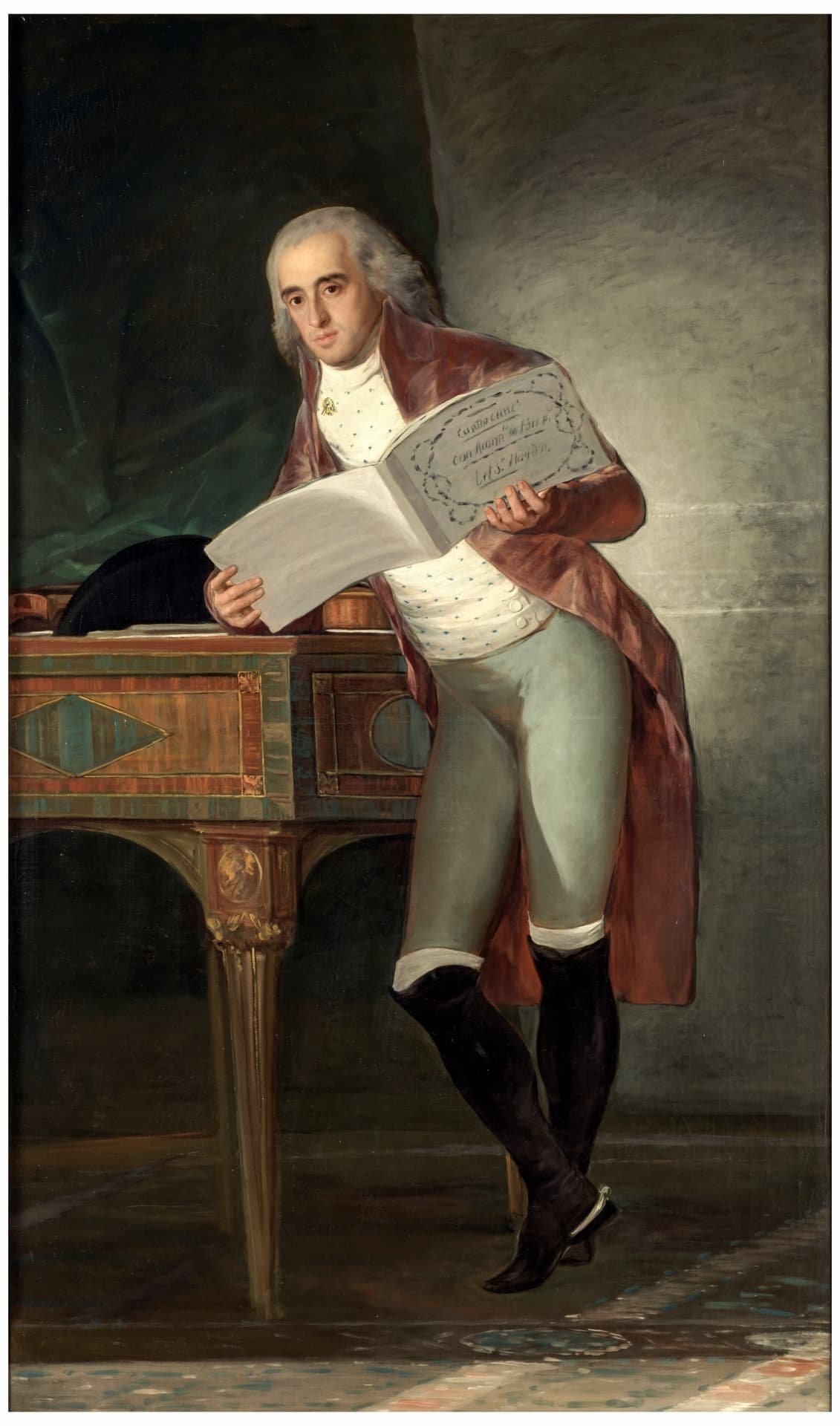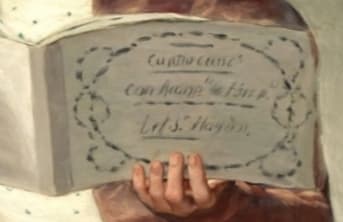What was the music held by the Duke in Goya’s “José Álvarez de Toledo”?
Around 1795, the Spanish painter Goya painted a picture of his patron, Don José Álvarez de Toledo Osorio y Gonzaga, 11th Marquess of Villafranca, Grandee of Spain, jure uxoris Duke of Alba de Tormes, Grandee of Spain (1756–1796).

Goya: José Álvarez de Toledo, the 11th Marquis of Villafranca, ca. 1795 (Museo del Prado)
The painting, now in the Museo del Prado in Madrid, shows the Duke, leaning against a piece of furniture, possibly a desk, a violin half-hidden behind him, a black hat at his elbow, holding a piece of music entitled ‘Cuatro compo con acompp de Fortepo del S.r Haydn’, the title surrounded by an oval decorative frame with additional curls of design. The Duke is shown in a russet velvet coat, green trousers, and a spotted green shirt with matching vest. He’s wearing black riding boots with spurs, indicating that he has more than just musical skills.
This intrigued us: what was the music?
Haydn had a direct connection with the Spanish court and Spanish patrons. He started working with Spaniards in the 1770s and the country’s archives and libraries hold hundreds of his works. The majority of these are works that customers bought from music dealers, but in a couple of cases, Haydn sent manuscripts. At the request of the royal family, Haydn himself sent several manuscripts from Eszterháza to the court, including the opera L’isola disabitata (written in 1779) and Symphonies 62 and 74 both written in 1780 or 1781. The Archives at the Royal Palace hold over sixty symphonies and a dozen baryton trios – some from the composer and some copies authorized by Haydn.
There is evidence from a letter from Haydn that one, perhaps two, string quartets were written for the Duke of Alba. The songs that the Duke holds, however, were not written for him, nor can any edition that corresponds to this piece of music be found. The Spanish brought their music from Italy or Austria and didn’t have their own publishing industry for this music.
In searches undertaken by scholars in the US, the UK, and Spain, there does not appear to be any 1790s publication in Spanish with the title of Four Songs (Cuatro composiciones). In looking at Haydn’s output, the best guess is that it’s probably VI Songs published in Vienna by Artaria (Hob. XXVIa: 13-24) that first appeared in 1784. It was reissued in 1794 and was joined by the English publication of VI Original Canzonettas (Hob.XXVIa: 25-30) from that same year. This argument is strengthened when we look at the actual 1794 publication of the VI original canzonettas, published by Haydn in London.

The music in the Goya painting (detail)
![Haydn: Dr. Haydn's VI Original Canzonettas for the Voice with an Accompaniment for the Piano-Forte, London: "for the Author & Sold by him at No.1 Bury Street, S.t James's..." [1794] (Sotheby’s)](https://interlude-cdn-blob-prod.azureedge.net/interlude-blob-storage-prod/2023/05/London-VI-original-canzonettas-1794.jpg)
Haydn: Dr. Haydn’s VI Original Canzonettas for the Voice with an Accompaniment for the Piano-Forte, London: “for the Author & Sold by him at No.1 Bury Street, S.t James’s…” [1794] (Sotheby’s)
The music in the London edition is in portrait mode, whereas Goya’s is in landscape mode, which was more typical for keyboard music than for vocal music. However, we do have the same oval decorative frame with decorative curls, similar to Goya’s picture.
How did we get to 4 songs? That might be a translation problem: VI songs becoming misremembered as IV songs and then getting translated into Spanish as Cuatro and so we have our mysterious book of four songs published in Spain. The historical record doesn’t show any of Haydn’s work being published in Spain at this time, so we have to blame it on Goya’s creative talents for presenting us with a music edition that never existed, based on a music edition that does exist.
Franz Joseph Haydn: 6 Original Canzonettas, Book 1, Hob.XXIVa:25-30 – No. 1. The Mermaid’s Song, Hob.XXVIa:25 (Julie Kaufmann, soprano; Donald Sulzen, piano)
Franz Joseph Haydn: 6 Original Canzonettas, Book 1, Hob.XXIVa:25-30 – No. 2. Recollection, Hob.XXVIa:26 (Julie Kaufmann, soprano; Donald Sulzen, piano)
Franz Joseph Haydn: 6 Original Canzonettas, Book 1, Hob.XXIVa:25-30 – No. 3. Pastoral Song, Hob. XXVIa:27 (Julie Kaufmann, soprano; Donald Sulzen, piano)
Franz Joseph Haydn: 6 Original Canzonettas, Book 1, Hob.XXIVa:25-30 – No. 4. Despair, Hob.XXVIa:28 (Julie Kaufmann, soprano; Donald Sulzen, piano)
Franz Joseph Haydn: 6 Original Canzonettas, Book 1, Hob.XXIVa:25-30 – No. 5. Pleasing Pain, Hob.XXVIa:2 (Julie Kaufmann, soprano; Donald Sulzen, piano)
Franz Joseph Haydn: 6 Original Canzonettas, Book 1, Hob.XXIVa:25-30 – No. 6. Fidelity, Hob.XXVIa:30 (Julie Kaufmann, soprano; Donald Sulzen, piano)
As a way of signalling how up-to-date he was, and how connected with the world, the Duke holds the latest songs by the leading international composer of his day, Haydn, showing his knowledge of music among his other qualities.
For more of the best in classical music, sign up to our E-Newsletter
